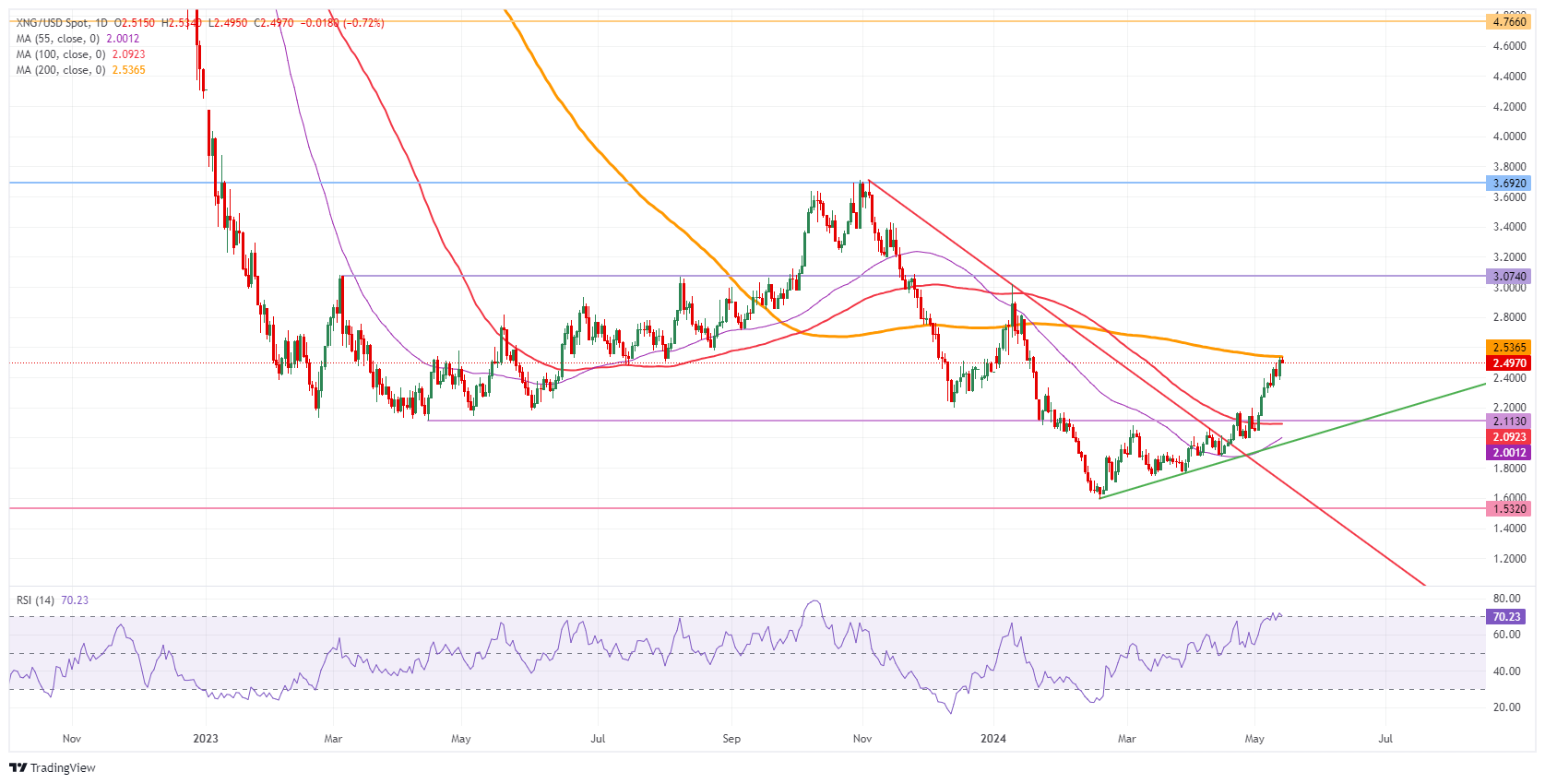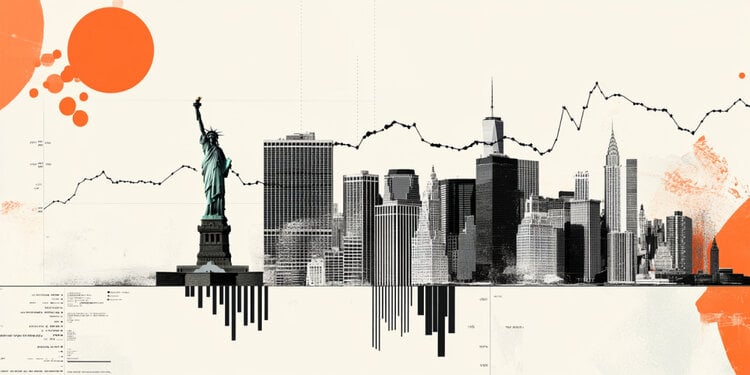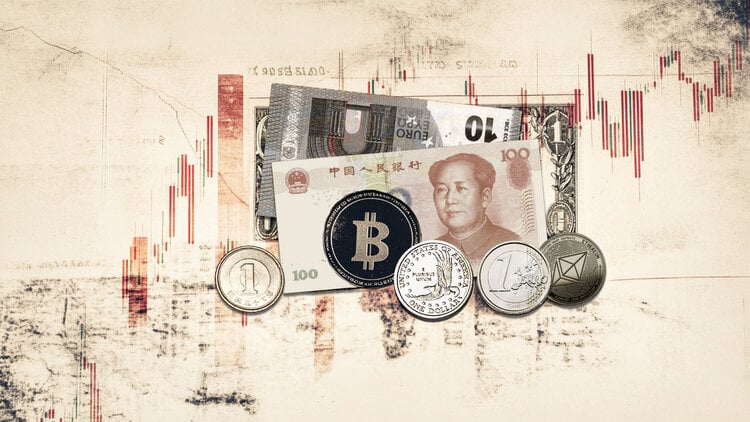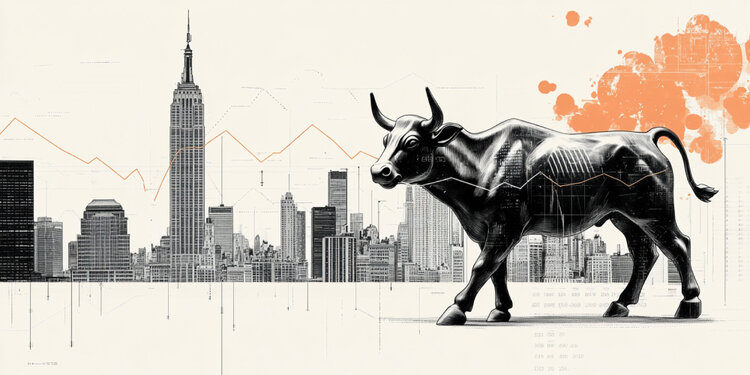- Natural Gas prices face an important limit of $2.53.
- Geopolitical risks diminish somewhat as the Qatar Economic Forum takes place.
- The US Dollar Index remains and consolidates above 105.00.
The price of Natural Gas (XNG/USD) has given traders a good run, up 40% since the end of March. This move is due in part to Israel's continued attacks on Gaza. With pressure from world leaders demanding at least a ceasefire from Israel, tensions are likely to ease. Meanwhile, Europe has secured sufficient gas supply ahead of the next heating season and ahead of important long-term measures that will come into force from 2025 in 2028, making the bloc independent of Russian gas.
The US Dollar Index (DXY), which tracks the value of the Dollar against six major currencies, is trading stably above the crucial support of 105.00 on Tuesday ahead of the US Federal Reserve (Fed) chairman's speech. Jerome Powell. Markets are already gearing up for April's Consumer Price Index (CPI), due out on Wednesday, so Fed Chair Powell's words on keeping rates higher for longer could influence the prospects for an initial Fed rate cut until late 2024 or even early 2025. The result of this scenario would be a stronger US Dollar overall, which would affect USD-denominated Gas prices.
Natural Gas is trading at $2.49 per MMBtu at the time of writing this report.
Natural Gas News: Comments from Qatar
- The World Economic Forum in Qatar began on Tuesday morning. Headlines from world leaders may appear throughout the week. Qatari Prime Minister Mohammed bin Abdulrahman Al Thani has already made an opening statement, condemning Israel's approach to Gaza and calling for peace and a ceasefire to reach an agreement that works for all parties, as broadcast by Bloomberg Television.
- The OPEC Monthly Market Report will be published on Tuesday. Even when it comes to oil, the energy complex as a whole could face tailwinds or tailwinds from any outlook or firm policy change.
- Germany will have to diversify its energy capacity by building new gas plants, as Bloomberg estimates that 25% of current coal plants will close by the end of the year.
- The Freeport LNG plant is producing Liquefied Natural Gas at the highest level in six months, following a prolonged period of unplanned outages and maintenance. Currently, the three production trains are jointly producing 2.09 billion cubic feet of Gas per day, Reuters reports.
Technical analysis of Natural Gas: Rally fatigue
The bullish trade in Natural Gas since the end of April is running out. The rally has reached the bottom of the line and faces firm rejection against the 200-day SMA at $2.53 on Tuesday. It will take a big catalyst or driver to get over that cap at the top.
If Gas price breaks above the 200-day SMA, the $3.00 marker is the first level to watch. Once breached, the fundamental level near $3.07 (March 6, 2023 high) will come into play and mark a new high for 2024. Higher up, there is room for a quick crossover towards $3.69.
To the downside, a double band is waiting to provide support with the 100-day SMA at $2.09 and the fundamental level at $2.11 (April 14, 2023 low). If this support zone does not hold, the ascending green trend line near $1.98, along with the 55-day SMA at $2.00, should prevent a further decline.

Natural Gas: Daily Chart
Frequently asked questions about Natural Gas
What fundamental factors determine the price of Natural Gas?
The dynamics of supply and demand is a key factor that influences Natural Gas prices, and in turn is influenced by global economic growth, industrial activity, population growth, production levels and inventories. Climate influences Natural Gas prices because more Gas is used during cold winters and hot summers for heating and cooling. Competition from other energy sources influences prices as consumers may opt for cheaper sources. Geopolitical events, such as the war in Ukraine, also play a role. Government policies related to extraction, transportation and environmental issues also influence prices.
What are the main macroeconomic publications that influence Natural Gas Prices?
The main economic publication that influences Natural Gas prices is the weekly inventory bulletin of the Energy Information Administration (EIA), a US government agency that produces data on the gas market in the United States. The EIA Gas bulletin usually comes out on Thursday at 14:30 GMT, the day after the EIA publishes its weekly Oil bulletin. The economic data of the large consumers of Natural Gas can influence supply and demand, among which China, Germany and Japan stand out. Natural gas is primarily priced and traded in US dollars, so economic releases affecting the US dollar are also factors.
How does the dollar influence Natural Gas prices?
The US dollar is the world's reserve currency and most commodities, including Natural Gas, are quoted and traded in international markets in US dollars. Therefore, the value of the Dollar influences the price of Natural Gas, since if the Dollar strengthens, fewer dollars are needed to buy the same volume of gas (the price falls), and vice versa if the dollar strengthens.
Source: Fx Street
I am Joshua Winder, a senior-level journalist and editor at World Stock Market. I specialize in covering news related to the stock market and economic trends. With more than 8 years of experience in this field, I have become an expert in financial reporting.







